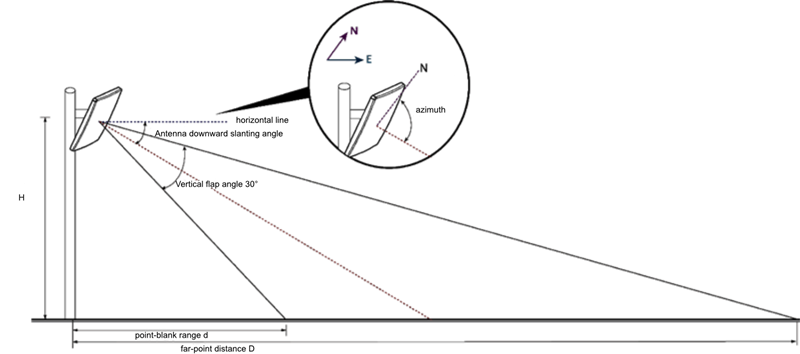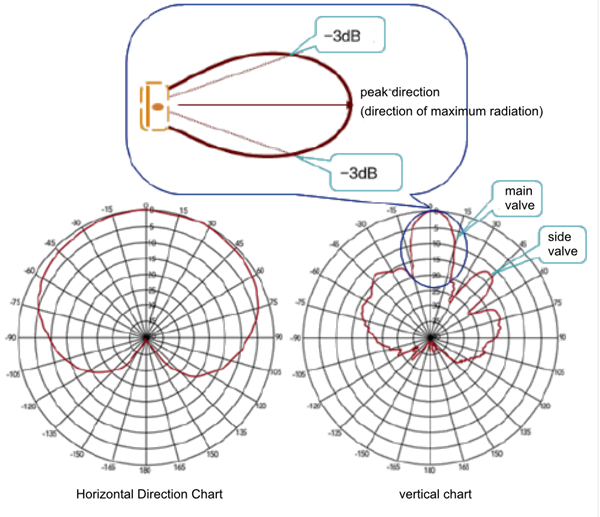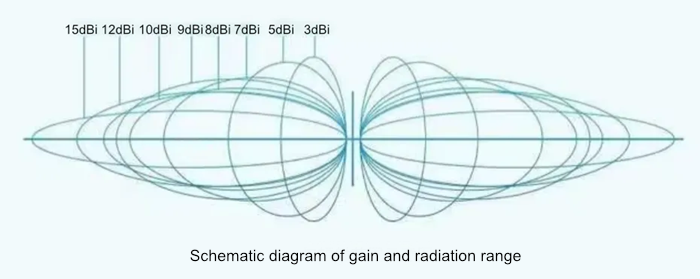
Profound and Detailed
Basic Knowledge of Antennas (2)
2024-10-25
This article continues from "Basic Knowledge of Antennas (1)".
Antenna angle
The antenna angle refers to the angle formed by the antenna with the north and horizontal directions respectively, which are the azimuth angle and downtilt angle respectively.
Antennas are divided into omnidirectional antennas and directional antennas according to their directivity. Omnidirectional antennas transmit or receive signals 360° on the horizontal plane, so generally speaking, the antenna angle refers to the azimuth angle and downtilt angle of the directional antenna.
The antenna angle is related to the antenna gain. The smaller the angle, the greater the gain. But when choosing a gain index, higher is not always better. The key is to meet the signal coverage requirements. Generally, the antenna signal coverage can be controlled by adjusting the antenna azimuth and downtilt angle.

• Azimuth angle: It is the angle formed by turning horizontally and clockwise from the north direction to the direction of the main lobe of the antenna.
• Downtilt angle: It is the angle between the direction of the main lobe of the antenna and the horizontal plane.
• Lobe angle: It is the angle formed in the antenna pattern 3dB below the main lobe peak.
Antenna gain
Antenna gain refers to the ratio of the radiation power density of the antenna in a specified direction to the radiation power density of the reference antenna (usually an ideal radiation point source) when the input power is the same. Parameters representing antenna gain include dBd and dBi.
• dBd: gain relative to a symmetrical array antenna.
• dBi: Relative to the gain of a point source antenna, the radiation is uniform in all directions.
• Ideal radiation point source: refers to an ideal isotropic antenna, that is, a simple point radiation source with the same radiation characteristics in all directions in space.
Antenna gain measures the ability of an antenna to send and receive signals in a specific direction and is one of the most important parameters for selecting an antenna. Gain is closely related to the antenna pattern. The narrower the main lobe of the pattern and the smaller the side lobe, the higher the gain. The relationship between main lobe width and antenna gain is shown in the figure.

Lobe width
Lobe width refers to the width of the angle formed at 3dB below the main lobe peak in the antenna pattern. Lobe width is an important indicator commonly used in directional antennas.
• Main lobe: Different antennas have different directional patterns. The directional patterns of some antennas are in the shape of many petals. The lobe with the highest radiation intensity is called the main lobe.
• Side lobes: In addition to the main lobe of the antenna pattern, the remaining lobes are called side lobes or secondary lobes.
The narrower the beam width, the better the directivity, the farther the operating distance, and the stronger the anti-interference ability. When covering, the main lobe is mainly considered. Side lobes usually interfere with surrounding areas. In general applications, the main lobe must be enhanced and side lobes suppressed. However, at the near-point position of the antenna, side lobes need to be considered to eliminate coverage blind spots.

Antenna selection
The transmission distance of the wireless module is mainly affected by the transmit power and receiving sensitivity. The antenna has a particularly obvious impact on the above parameters. Parameters such as the resonant frequency, bandwidth, gain, standing wave ratio, and characteristic impedance of the antenna are important indicators for considering the performance of the antenna.
Industrial wireless short-distance micropower communication modules commonly use vertically polarized, 50-ohm characteristic impedance antennas. Users need to consider three parameters: resonant frequency, gain, and standing wave ratio when choosing an antenna. Of course, the antenna type is the primary consideration. Ceramic mount antennas and soft board printing are small in size and can be installed inside the product casing without affecting the appearance; glue stick antennas are large in size and need to be installed outside the user's product casing; suction cup antennas have long leads. , can be installed at a certain distance from the user's product, but its performance is affected by its adsorbed objects.
• Resonant frequency is commonly known as the antenna operating frequency. Most users report that large differences in overall communication distance are caused by not selecting an antenna with the correct resonant frequency.
• Standing wave ratio (voltage standing wave ratio) refers to the ratio of the antinode voltage of the antenna standing wave to the trough voltage amplitude. It reflects the matching degree of the antenna and the transmission line system and the ability of the antenna to convert electrical energy into electromagnetic energy. Under ideal conditions, the standing wave ratio = 1, which means that the transmission line system and the antenna are completely matched. The antenna radiates all the energy to free space and no energy is reflected to the transmission line; the standing wave ratio is infinite, which means that all the energy is reflected to the transmission line system and no energy is radiated to the free space. space. Therefore, when selecting an antenna, the closer the standing wave ratio parameter is to 1, the better. Generally, any antenna with a standing wave ratio lower than 2 can be considered excellent.
• Gain, in the field of antennas, represents the concentration of antenna radiation. It can be seen that the radiation ability of omnidirectional antennas is also directional, and improper selection or installation will also affect the overall performance. Under the same conditions, the higher the gain, the farther the electromagnetic wave propagates. However, in actual implementation, the antenna gain should be reasonably selected on the premise that the beam and the coverage target area match.

Microcyber's smart wireless products use WirelessHART wireless technology that focuses on process automation. It has the characteristics of self-organizing network, self-healing, low power consumption, data encryption, etc., ensuring reliable operation and flexible and fast installation. Through our wireless modules, wireless gateways, wireless adapters, wireless temperature transmitters and other products, we can quickly realize data collection, process monitoring, equipment operation, maintenance and diagnosis of complex industrial sites. Microcyber's smart wireless products have become the preferred industrial wireless communication solution for domestic end customers. Internationally renowned companies have also joined the ranks of cooperation, and have been widely used in petrochemical, electric power, metallurgy, machinery manufacturing and other fields.
Industrial Internet Access Point
Microcyber is committed to the research and development, production, sales and integrated application of industrial IoT products.
Microcyber is the first fieldbus protocol stack in China and the third in the world to pass international certification, the first fieldbus instrument in China to pass international certification, the first demonstration application of networked control system in China, and the first function in China to pass international certification, the first wireless HART product in China to pass international certification, etc.
Microcyber is one of the main undertaking units of important national science and technology projects in the fields of industrial Internet of Things and industrial automation. Over the years, we had undertaken a number of major national science and technology projects, the National High Technology Research and Development Plan (863 Plan), and the development of intelligent manufacturing equipment. Special projects and other national science and technology plans.
Microcyber has accumulated rich experience in technical capabilities, technical achievements and technical reserves, and has a strong R&D team to protect the sustainable development of the company's products.
<< Previous page
Next page >>